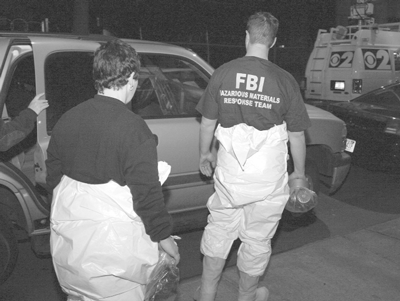By Lincoln Anderson
A week after a Greenwich Village man was reported to have contracted natural anthrax from raw goatskins he used making African drums, the city was reassuring parents at an East Village elementary school where the man recently performed that their children were not at risk of contracting the deadly bacteria.
Meanwhile, Vado Diomande, 44, of 31 Downing St., remained in stable condition at a hospital in Pennsylvania, where he collapsed on Feb. 16 after giving a performance at a college.
David Cantor, a Department of Education spokesperson, said Diomande gave a concert at P.S. 63 on E. Third St. on Feb. 3. and that it was the only New York City public school at which Diamonde performed. Diamonde reportedly also gave lessons at a private school.
D.O.E. sent a letter to P.S. 63 parents last Thursday informing them their children were not at risk of contracting anthrax at the concert. D.O.E. also sent the letter to parents at the Earth School, which is located in the P.S. 63 building, but which did not have any students at the concert, to allay any fears they might have and so they wouldn’t be surprised by the news. A meeting held at the school with Department of Health and Education officials was attended by at least 50 parents, the spokesperson said.
Cantor said that, according to the Health Department, “Once the drums are made and processed, there is no more anthrax.” The Health Department’s Web site says how Diomande contracted inhalation Anthrax is very rare and happened because he worked with the skins in a confined space. One news article said the spores were in the skins’ hair, which Diomande sliced off when making the drumheads.
Low levels of anthrax were found at a warehouse in Dumbo, Brooklyn, where Diomande worked on his drums, at his Village apartment and in his van. The skins were never at Downing St., however, according to the Health Department. Mayor Bloomberg has said both sites will undergo a full cleanup and that there’s no health risk. Seven people who may have come in contact with the goatskins — including Diomande’s wife — are being given antibiotics as a precaution. A third site, a Crown Heights apartment, tested negative for anthrax.
A highly regarded West African drummer and dancer, Diomande has worked closely with Kiboko Projects, a Grand St.-based program sponsoring cultural-exchange arts and education programs between the United States, Africa and Russia. As part of Kiboko’s “Diary Project” exhibitions, Diomande performed about eight times with them, including at least twice at St. Mark’s Church-in-the-Bowery on E. 10th St. and Second Ave. and once at the Puffin Room Gallery on Broome St. in Soho.
Mark Scheflen, Kiboko Project’s artistic director, said Diomande also performed at the American Museum of Natural History for Kwanza.
“We know Vado very well,” he said.
Jill Raufman, Kiboko Projects executive director, is especially close to Diomande and his wife, a former student of his who manages his Kotchegna Dance Company. Raufman met Diomande as a student in his African-dance class at Djoniba on E. 18th St. between Broadway and Park Ave. She said Diomande married four or five years ago, and that since then he’s lived in the Village, where his wife had already resided for awhile.
“There’s just a quality about him that’s very special. He’s the best teacher at Djoniba,” Raufman said. “He also makes drums — people come from all over the world for that.”
It was reported that Diomande had cutaneous anthrax a few years ago, requiring a skin graft on his thigh. However, Raufman said Diomande never knew he had anthrax before, and was told it might have been a flesh-eating disease like Ebola. She said that in 2003 Diomande had first visited the Ivory Coast, in Africa, and that when he got off the plane in Amsterdam, where he was going to perform, his leg was badly swollen. Other performers in the troupe later found him feverish in his hotel room and took him to the hospital.
“They said, at the time, somebody else would have died — and forget about walking or dancing again,” Raufman said. “He’s incredibly strong.”
Last December, Diomande again visited the Ivory Coast for a couple of weeks. Raufman said he made the trip because in October someone stole the special masks — which are very expensive — that he wears during his specialty — stilt-dance performances in which he communes with ancestors. It’s believed the anthrax spores may have been among four goatskins he brought back from Africa this time.
His new masks were stolen from his van again in December, Raufman said.
Usually quiet Downing St. was abuzz with activity last Wednesday.
“There are helicopters and cops and N.P.R. is reporting on it,” said Livvie Mann, president of the Bedford Downing Block Association, over the phone late Wednesday afternoon.
The area in front of Diomande’s building was cordoned off as F.B.I. agents and police Emergency Service Unit officers wearing white hazmat suits and blue oxygen tanks on their backs could be seen going in and out of the building as they checked his apartment for the presence of anthrax.
“Most of the activity is usually over there at Blue Ribbon restaurant,” observed Don Corrigan, a retiree, of the usually tranquil intersection, adding, “I think the block association should take this up, instead of worrying about tree guards and parking signs.”
“It’s scary! I can’t even believe it. I’ve lived here forever,” said Lillian Moore, 25 — who had been on her way to Ino restaurant nearby — after being told what was going on. “It’s normally so low-key, that’s why I had to stop.”
“I was in the house. I saw all these cars, cops, with the big [TV news] pole, van,” said Frank Napolitano, 76, standing on his stoop. He said he frequently sees the landlady of 31 Downing St., Mary Piazza, walking her German shepherd puppy up and down the block.
Police spokespersons at the scene assured that the exterior of the building and area in front of the building were anthrax free. They handed out an anthrax fact sheet to building residents detailing the three types of anthrax — skin, lung and gastrointestinal — and noting that inhalation anthrax cannot be spread from person to person or by living in the same building with someone infected with anthrax.
The first night, police allowed people in and out of the 15-unit building, but not up to the fifth floor, where Diomande’s apartment is. But if people were already in fifth-floor apartments with their doors closed, they were allowed to stay inside.
Sometime early Thursday morning, the police tape around the street in front of the building was removed. A Sixth Police Precinct officer was posted in the vestibule in the days afterward to keep reporters and others from going up to Diomande’s apartment.


















